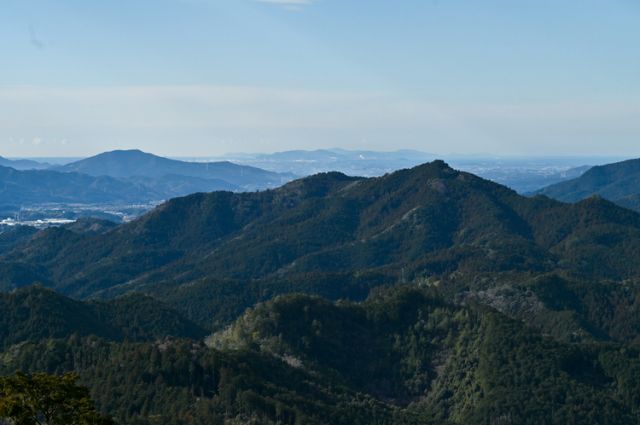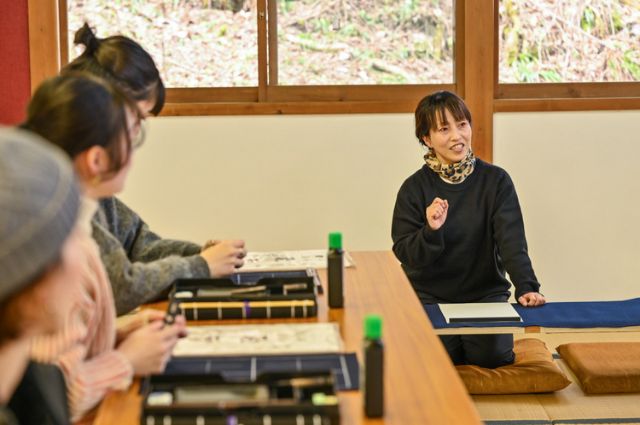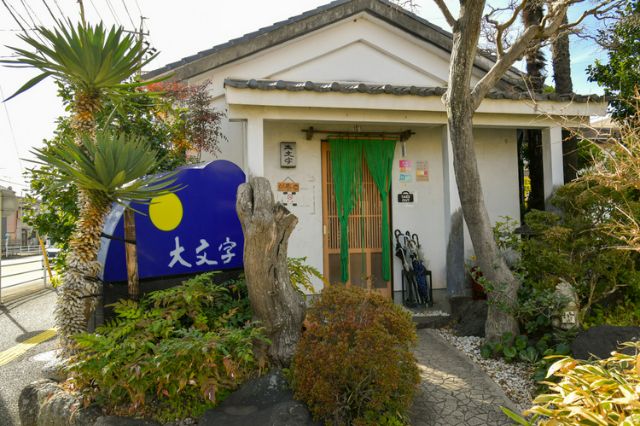Shinshiro City in Aichi Prefecture. Despite being just over an hour away from Nagoya, it's a small town that few people know about its charm. However, it's a wonderful town where the richness of vast nature, nurtured ingredients such as Japanese beef, and deeply rooted culture and history converge, making it a place where the charm of Japan is tightly packed and condensed.
9:30 am: Visiting the Horaisan Toshogu Shrine
Mt. Horaiji, which we climbed on the first day, can be reached by car up to near the summit.
We're heading to Mt. Houkiji by car this time, after climbing the stone steps on the first day. The "Horaisan Toshogu Shrine," located a short walk from Horaiiji Temple, was established in 1648 by Tokugawa Iemitsu, the third shogun of the Tokugawa shogunate. It is said that Tokugawa Iemitsu learned of the episode where Tokugawa Ieyasu's parents prayed at Mt. Horaiji and as a result, Ieyasu was born. This prompted Iemitsu to establish the shrine to enshrine Ieyasu.
The entire precinct, surrounded by a cedar grove with trees aged 370 years, feels like Energy hotspot.
Several buildings, including the "haiden" (worship hall), are designated as important cultural properties by the government.
In the "haiden," there is a replica of the full-body golden armor called "Kindamigusoku" that Tokugawa Ieyasu wore, as well as a statue of Tokugawa Ieyasu himself, creating a solemn atmosphere.
This is also the "Chumon" (Middle Gate), designated as an important cultural property by the government. It retains the architectural style of the early Edo period and features a "Ikko-hira Karamon" (single-ridge, Chinese-style gate).
Beyond the "Chumon," there is the "Honden" (main hall) built in the "Irimoya-zukuri" style, adorned with beautiful carvings. Inside the Honden, there is another shrine called the "Gokuden," where it is said that Tokugawa Ieyasu's hair and teeth are enshrined.
Throughout the precinct, there are over 50 sculptures, each showcasing vivid colors and intricate details, captivating visitors with their beauty.
10:30 am: Calligraphy experience in nature.
This time, Ms. Hachisuka will be giving the lecture.
After a short walk from the Horaisan Toshogu Shrine, you'll find yourself on the lush grounds of Houraiji Temple, which is also used as temple lodging. Here, you can experience calligraphy. In Japan, many people only experience calligraphy during their elementary school years, when they write New Year's greetings as part of their lessons. As adults, it's surprisingly rare to have the opportunity to engage in such an experience.
First, we start by grinding solid ink to make ink.
"During the process of grinding this ink, I particularly enjoy the pleasant fragrance of the ink and the tranquilizing sound, which calms my mind," says Ms. Hachisuka. Calligraphy, by engaging all five senses, transforms into a more intimate experience.
With specific advice, you'll improve rapidly even in a short time.
The kanji that became the focus this time is "永" (nagai, ei), which means "eternity" or "forever."
As it is said in the "Eiji Happo" (Eight Principles of the Character "永"), the kanji "永" encompasses all eight basic techniques required in calligraphy, including "tome" (stopping), "hane" (jumping), and "harai" (sweeping). By mastering "永," one can apply these techniques to other kanji characters.
Before we knew it, time flew by as we were immersed in the desire to write better, and it felt like there wasn't enough time.
12:00 pm: Wrapping up the journey with a lunch featuring Horai Beef.
In front of Shinshiro City Hall is the Daimoji.
We visited Daimoji, seeking a delicious lunch that would be a fitting end to our journey. Located in the heart of Shinshiro City, it's bustling with locals during lunchtime. They use local ingredients for over 90% of their vegetables, and they source their fish from the Miya fishing port in Gamagori, making their locally produced and locally consumed dishes popular among visitors.
The name of the set meal, filled with the desire to accompany you during your enjoyable time, is "Holiday."
The "Holiday" set meal consists of three dishes. The main dish, featuring Horai beef, is a simple dish where the thigh meat is cooked at a low temperature and served with a soy-scented sauce. It's complemented by refreshing homemade yuzu kosho, which cuts through the fat. Accompanying this are the famous "Tomato Oden" and "Taro Croquette" as part of the set.
The "Tomato Oden," created by the owner, Mr. Asada, who is fond of Italy, is addictively delicious with its spicy flavor that brings out the acidity of the tomatoes! You'll enjoy it by gently breaking apart the tomatoes as you eat.
Mr. Asada devised this menu with the intention of allowing people to enjoy the specialties of various areas within Shinshiro City, which was originally formed by the merger of three towns. This menu incorporates Horai beef from the former Horai town, tomatoes from the former Tsukude village, and taro from the former Shinshiro City. It could be said to be a one-plate dish that encapsulates the charm of Shinshiro City.
The "Taro Croquette" contains wood ear mushrooms. It's a particularly popular dish on the evening menu.
Daimonji
Phone Number: 050-5870-7155
Address: 1 Nishi-Irifune, Shinshiro-shi, Aichi
Closed: None
Open: Lunch 11:30 am - 2:00 pm, Dinner 5:00 pm - 10:00 pm
View of the area around the Kyu Kadoya Elementary School from near the summit of Mt Horaiji.
Shinshiro City may not be a large city, but it offers vast natural landscapes, wonderful local produce nurtured by its environment, blessed hot springs, and the warm hospitality of its local residents. It's a town packed with the charm of Japan. Shinshiro hides many undiscovered charms, and I highly recommend visiting at least once to experience them for yourself.
≫ Apply for the tour hereDisclaimer: All information is accurate at time of publication.
![[Day 3] Exploring Shinshiro: A City Packed with Japanese Charm. Immerse Yourself in Local Travel, Enjoying Nature, Hot Springs, and Cuisine | Shinshiro City Wellness Tour](https://rimage.savorjapan.com/svj_tmp/image/discover_oishii_japan/2053/article_head.jpg?t=1709065801)

![[Day 3] Exploring Shinshiro: A City Packed with Japanese Charm. Immerse Yourself in Local Travel, Enjoying Nature, Hot Springs, and Cuisine | Shinshiro City Wellness Tour](https://rimage.savorjapan.com/svj/image/discover_oishii_japan/2053/article_180481_w640z.jpg)
![[Day 3] Exploring Shinshiro: A City Packed with Japanese Charm. Immerse Yourself in Local Travel, Enjoying Nature, Hot Springs, and Cuisine | Shinshiro City Wellness Tour](https://rimage.savorjapan.com/svj/image/discover_oishii_japan/2053/article_180482_w640z.jpg)
![[Day 3] Exploring Shinshiro: A City Packed with Japanese Charm. Immerse Yourself in Local Travel, Enjoying Nature, Hot Springs, and Cuisine | Shinshiro City Wellness Tour](https://rimage.savorjapan.com/svj/image/discover_oishii_japan/2053/article_180483_w640z.jpg)
![[Day 3] Exploring Shinshiro: A City Packed with Japanese Charm. Immerse Yourself in Local Travel, Enjoying Nature, Hot Springs, and Cuisine | Shinshiro City Wellness Tour](https://rimage.savorjapan.com/svj/image/discover_oishii_japan/2053/article_180484_w640z.jpg)

![[Day 3] Exploring Shinshiro: A City Packed with Japanese Charm. Immerse Yourself in Local Travel, Enjoying Nature, Hot Springs, and Cuisine | Shinshiro City Wellness Tour](https://rimage.savorjapan.com/svj/image/discover_oishii_japan/2053/article_180486_w640z.jpg)
![[Day 3] Exploring Shinshiro: A City Packed with Japanese Charm. Immerse Yourself in Local Travel, Enjoying Nature, Hot Springs, and Cuisine | Shinshiro City Wellness Tour](https://rimage.savorjapan.com/svj/image/discover_oishii_japan/2053/article_180487_w640z.jpg)
![[Day 3] Exploring Shinshiro: A City Packed with Japanese Charm. Immerse Yourself in Local Travel, Enjoying Nature, Hot Springs, and Cuisine | Shinshiro City Wellness Tour](https://rimage.savorjapan.com/svj/image/discover_oishii_japan/2053/article_180488_w640z.jpg)
![[Day 3] Exploring Shinshiro: A City Packed with Japanese Charm. Immerse Yourself in Local Travel, Enjoying Nature, Hot Springs, and Cuisine | Shinshiro City Wellness Tour](https://rimage.savorjapan.com/svj/image/discover_oishii_japan/2053/article_180489_w640z.jpg)

![[Day 3] Exploring Shinshiro: A City Packed with Japanese Charm. Immerse Yourself in Local Travel, Enjoying Nature, Hot Springs, and Cuisine | Shinshiro City Wellness Tour](https://rimage.savorjapan.com/svj/image/discover_oishii_japan/2053/article_180491_w640z.jpg)
![[Day 3] Exploring Shinshiro: A City Packed with Japanese Charm. Immerse Yourself in Local Travel, Enjoying Nature, Hot Springs, and Cuisine | Shinshiro City Wellness Tour](https://rimage.savorjapan.com/svj/image/discover_oishii_japan/2053/article_180492_w640z.jpg)
![[Day 3] Exploring Shinshiro: A City Packed with Japanese Charm. Immerse Yourself in Local Travel, Enjoying Nature, Hot Springs, and Cuisine | Shinshiro City Wellness Tour](https://rimage.savorjapan.com/svj/image/discover_oishii_japan/2053/article_180493_w640z.jpg)
![[Day 3] Exploring Shinshiro: A City Packed with Japanese Charm. Immerse Yourself in Local Travel, Enjoying Nature, Hot Springs, and Cuisine | Shinshiro City Wellness Tour](https://rimage.savorjapan.com/svj/image/discover_oishii_japan/2053/article_180494_w640z.jpg)


![[Day 1] Exploring Shinshiro: A City Packed with Japanese Charm. Immerse Yourself in Local Travel, Enjoying Nature, Hot Springs, and Cuisine | Shinshiro City Wellness Tour](/gg/content_image/%2Fimage%2Fdiscover_oishii_japan%2F2051%2Farticle_head_150x105z.jpg)
![[Day 2] Exploring Shinshiro: A City Packed with Japanese Charm. Immerse Yourself in Local Travel, Enjoying Nature, Hot Springs, and Cuisine | Shinshiro City Wellness Tour](/gg/content_image/%2Fimage%2Fdiscover_oishii_japan%2F2052%2Farticle_head_150x105z.jpg)





![Azabudai Hills [SUMI] (Janu Tokyo) ~ Editor's Afterword by the Editor-in-Chief of Japan's Gourmet Site](/gg/content_image//image/discover_oishii_japan/6536/article_head_150x105z.jpg)









